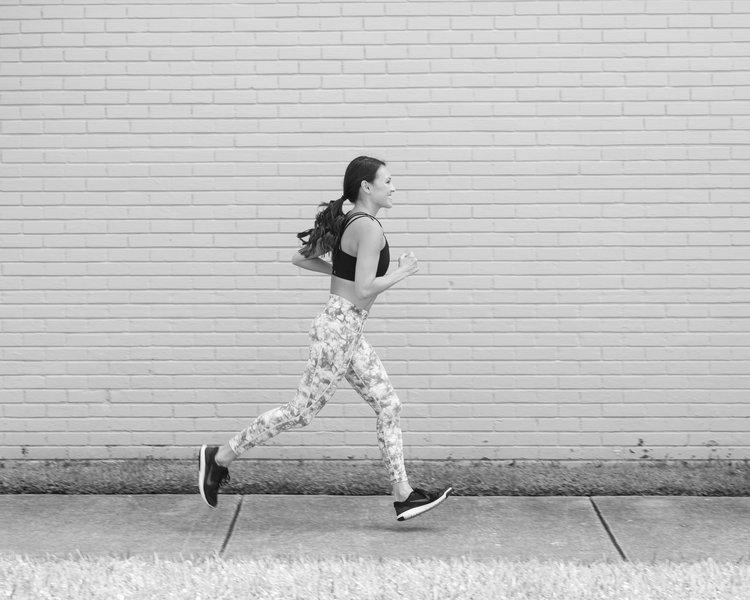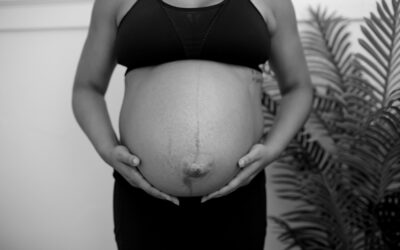Historically, there haven’t been many guidelines to help new moms learn how to safely return to running postpartum.
In March of 2019, three physiotherapists in the UK published the first such guidelines. This is excellent news!
These guidelines connect pelvic health signs/symptoms to the musculoskeletal and mechanical components of running. They use currently available pelvic health research outcomes in order to create individualized running programs for postpartum clients.
How to Return to Running Postpartum
Whether a casual three mile jog or a competitive marathon, it’s important to re-start running safely and gradually.
Sports medicine professionals emphasize the significance of a well-structured return to running program. This applies to female athletes and casual runners alike.
After having a baby, your abdominal wall and pelvic floor tissues are stretched, weak, and may be injured. High impact activities dramatically increase that pressure in your abdomen and demand on the pelvic floor.
Returning to high impact sports too soon can lead to pelvic organ prolapse, urinary incontinence, sexual dysfunction, and pain.
Your postpartum return to running may take time.
You may have been at the gym six days a week before giving birth, or never been to a workout class in your life! Regardless, start by allowing time for your tissues to heal with a period of relative rest.
Getting the “all clear” at your 6-week checkup just means there’s nothing requiring immediate medical attention. This does NOT mean that your tissues have finished healing or are prepared for high impact activities.
In the first three months after giving birth, it is important to rest and practice breathwork. It is also important to maintain good posture and do gentle exercises to strengthen your core.
This is a perfect time to check out pelvic floor physical therapy! Even if you feel symptom-free, to treat and prevent issues and set a foundation for getting back to all of your desired activities. Incorporating strength training exercises, such as calf raises and single-leg exercises, can be beneficial in this phase.
Key research takeaways for how to return to running postpartum
Reading dense scientific studies is not how most mothers with a newborn want to spend their time. So, here’s a quick summary of this latest research.
Pelvic Floor Therapy Postpartum
New moms can all benefit from a pelvic health check-up in the first six weeks postpartum. This is key for prevention and management of pelvic organ prolapse, urinary incontinence, and sexual dysfunction.
When To Reintroduce Running
- Train and strengthen your pelvic floor and core in those first 12 weeks after birth.
- Wait at least 12 weeks before you return to running and adding high impact workouts.
- You can start incorporating running slowly back into your routine starting 3-6 months postpartum. This is only if you don’t have any symptoms of pelvic floor dysfunction!
How to Start Running Again
- Gradually return to running by starting with walking and running intervals.
- Increase volume before intensity – that means increase distance and frequency before starting sprints or trail running.
- Remember that cross-training, recovery strategies, and sleep are key to success.
Red flags to watch for
Your pelvic health physical therapist can check for pelvic floor issues, but knowledge is power. Here are a few signs, symptoms, and risk factors of pelvic floor dysfunction to be aware of when returning to running postpartum:
- Leaking urine or feces
- Difficulty pooping
- Painful sex
- Pelvic and/or low back pain
- Heaviness, pressure, or bulging in the low pelvis
- Increased bleeding or pain
Working with a professional pelvic floor physical therapist can help you create a plan to reach your running goals. Knowing how you are healing postpartum, and knowing what to do for your specific needs, is powerful. Being able to balance risk and reward towards your goals wisely is important.
Pelvic Floor Physical Therapy is for everyone!
Adding a structured return to running program, including exercises like calf raises, single-leg exercises, and strength training, is key for postpartum recovery. These exercises are a great place to start:
#1 Bridges
Lie on your back with your knees bent and feet flat on the floor. Inhale.
Engage your pelvic floor with a Kegel contraction, then engage your core and pull your belly button in toward your spine.
Push your hips off the floor, aligning them with your knees and shoulders. Hold for 3 breaths. Repeat 5 times.
#2 Single Leg Bridges
Lie on your back with knees bent, feet flat on the floor. Straighten your right leg, keeping thighs in line.
Contract your pelvic floor and core, press through the foot that is flat on the floor to lift your hips off the ground into a bridge pose. Try to keep your hips level while squeezing your glutes to help you lift. Lower back down and repeat 5x, then switch to the left leg.
#3 Forward Lunges
Start in a standing position with feet shoulder width apart and pointing forward. Contract your pelvic floor and deep core muscles and take a long step forward with your right leg, lowering yourself until your right knee is bent at 90 degrees and your thigh is parallel with the ground. Step back with your right leg returning back to the starting position.
#4 Monster Walk with Band
Place a light resistance band around your ankles and stand with your feet shoulder-width apart. With a slight bend in the knees, contract pelvic floor and step to the side with your left foot, keeping your right foot planted. Return the left foot to starting position and release. Repeat 10x, then switch sides.
Ease your postpartum body back into running with the V-Hive!
The V-Hive postpartum workout program is specifically designed to rebuild your pelvic floor and core strength after birth for return to exercise. Gradually adding activities to build strength and endurance can help prevent injuries. It can also boost your confidence as you ease back into running. Remember, taking it slow and steady is the best approach to long-term success.








